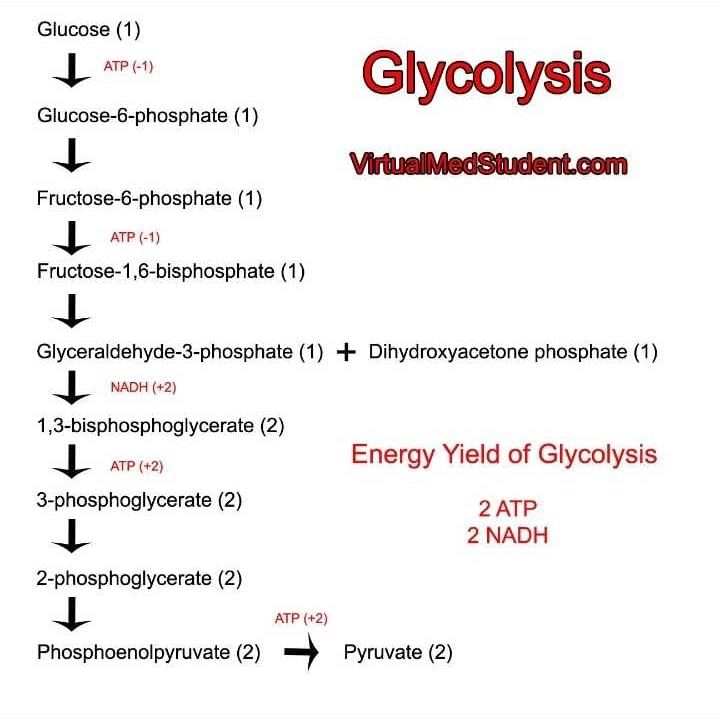NEET Exam > NEET Questions > The net gain of ATP molecules by glycolysis i...
Start Learning for Free
The net gain of ATP molecules by glycolysis is
- a)Zero
- b)Two
- c)Four
- d)Eight
Correct answer is option 'B'. Can you explain this answer?
Most Upvoted Answer
The net gain of ATP molecules by glycolysis isa)Zerob)Twoc)Fourd)Eight...
Glycolysis is the initial stage of both aerobic and anaerobic respiration. It occurs in the cytoplasm of cells and involves the breakdown of glucose into pyruvate. In the process, ATP molecules are produced.
Net Gain of ATP Molecules by Glycolysis
The net gain of ATP molecules by glycolysis is two. This occurs through the following steps:
1. Energy Investment Phase
In this phase, two ATP molecules are used to convert glucose into fructose-1,6-bisphosphate. This reaction is catalyzed by the enzyme phosphofructokinase.
Glucose + 2ATP → Fructose-1,6-bisphosphate + 2ADP
2. Cleavage Phase
In this phase, fructose-1,6-bisphosphate is cleaved into two molecules of glyceraldehyde-3-phosphate. This reaction is catalyzed by the enzyme aldolase.
Fructose-1,6-bisphosphate → 2 Glyceraldehyde-3-phosphate
3. Energy Liberation Phase
In this phase, each molecule of glyceraldehyde-3-phosphate is converted into pyruvate. This reaction involves the production of four ATP molecules and two NADH molecules.
2 Glyceraldehyde-3-phosphate + 4ADP + 2Pi + 2NAD+ → 2 Pyruvate + 4ATP + 2NADH + 2H+
Overall, the net gain of ATP molecules by glycolysis is two. This is because two ATP molecules are used in the energy investment phase, and four ATP molecules are produced in the energy liberation phase, resulting in a net gain of two ATP molecules.
Net Gain of ATP Molecules by Glycolysis
The net gain of ATP molecules by glycolysis is two. This occurs through the following steps:
1. Energy Investment Phase
In this phase, two ATP molecules are used to convert glucose into fructose-1,6-bisphosphate. This reaction is catalyzed by the enzyme phosphofructokinase.
Glucose + 2ATP → Fructose-1,6-bisphosphate + 2ADP
2. Cleavage Phase
In this phase, fructose-1,6-bisphosphate is cleaved into two molecules of glyceraldehyde-3-phosphate. This reaction is catalyzed by the enzyme aldolase.
Fructose-1,6-bisphosphate → 2 Glyceraldehyde-3-phosphate
3. Energy Liberation Phase
In this phase, each molecule of glyceraldehyde-3-phosphate is converted into pyruvate. This reaction involves the production of four ATP molecules and two NADH molecules.
2 Glyceraldehyde-3-phosphate + 4ADP + 2Pi + 2NAD+ → 2 Pyruvate + 4ATP + 2NADH + 2H+
Overall, the net gain of ATP molecules by glycolysis is two. This is because two ATP molecules are used in the energy investment phase, and four ATP molecules are produced in the energy liberation phase, resulting in a net gain of two ATP molecules.
Free Test
FREE
| Start Free Test |
Community Answer
The net gain of ATP molecules by glycolysis isa)Zerob)Twoc)Fourd)Eight...


|
Explore Courses for NEET exam
|

|
Question Description
The net gain of ATP molecules by glycolysis isa)Zerob)Twoc)Fourd)EightCorrect answer is option 'B'. Can you explain this answer? for NEET 2025 is part of NEET preparation. The Question and answers have been prepared according to the NEET exam syllabus. Information about The net gain of ATP molecules by glycolysis isa)Zerob)Twoc)Fourd)EightCorrect answer is option 'B'. Can you explain this answer? covers all topics & solutions for NEET 2025 Exam. Find important definitions, questions, meanings, examples, exercises and tests below for The net gain of ATP molecules by glycolysis isa)Zerob)Twoc)Fourd)EightCorrect answer is option 'B'. Can you explain this answer?.
The net gain of ATP molecules by glycolysis isa)Zerob)Twoc)Fourd)EightCorrect answer is option 'B'. Can you explain this answer? for NEET 2025 is part of NEET preparation. The Question and answers have been prepared according to the NEET exam syllabus. Information about The net gain of ATP molecules by glycolysis isa)Zerob)Twoc)Fourd)EightCorrect answer is option 'B'. Can you explain this answer? covers all topics & solutions for NEET 2025 Exam. Find important definitions, questions, meanings, examples, exercises and tests below for The net gain of ATP molecules by glycolysis isa)Zerob)Twoc)Fourd)EightCorrect answer is option 'B'. Can you explain this answer?.
Solutions for The net gain of ATP molecules by glycolysis isa)Zerob)Twoc)Fourd)EightCorrect answer is option 'B'. Can you explain this answer? in English & in Hindi are available as part of our courses for NEET.
Download more important topics, notes, lectures and mock test series for NEET Exam by signing up for free.
Here you can find the meaning of The net gain of ATP molecules by glycolysis isa)Zerob)Twoc)Fourd)EightCorrect answer is option 'B'. Can you explain this answer? defined & explained in the simplest way possible. Besides giving the explanation of
The net gain of ATP molecules by glycolysis isa)Zerob)Twoc)Fourd)EightCorrect answer is option 'B'. Can you explain this answer?, a detailed solution for The net gain of ATP molecules by glycolysis isa)Zerob)Twoc)Fourd)EightCorrect answer is option 'B'. Can you explain this answer? has been provided alongside types of The net gain of ATP molecules by glycolysis isa)Zerob)Twoc)Fourd)EightCorrect answer is option 'B'. Can you explain this answer? theory, EduRev gives you an
ample number of questions to practice The net gain of ATP molecules by glycolysis isa)Zerob)Twoc)Fourd)EightCorrect answer is option 'B'. Can you explain this answer? tests, examples and also practice NEET tests.

|
Explore Courses for NEET exam
|

|
Signup for Free!
Signup to see your scores go up within 7 days! Learn & Practice with 1000+ FREE Notes, Videos & Tests.


















